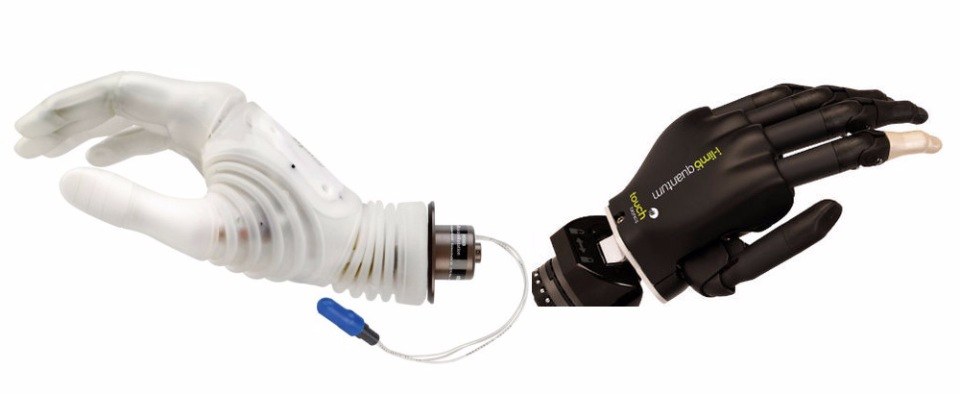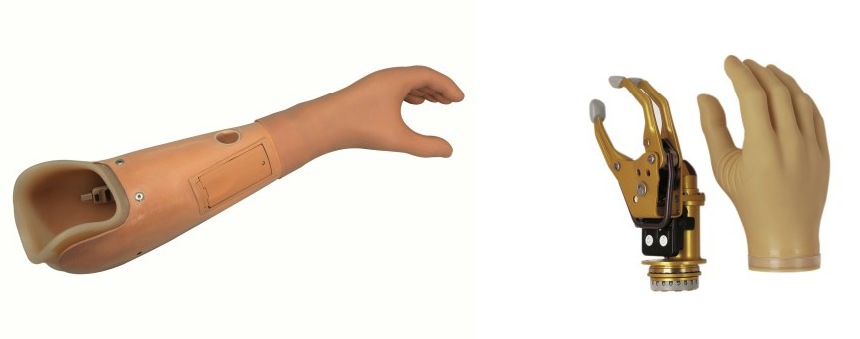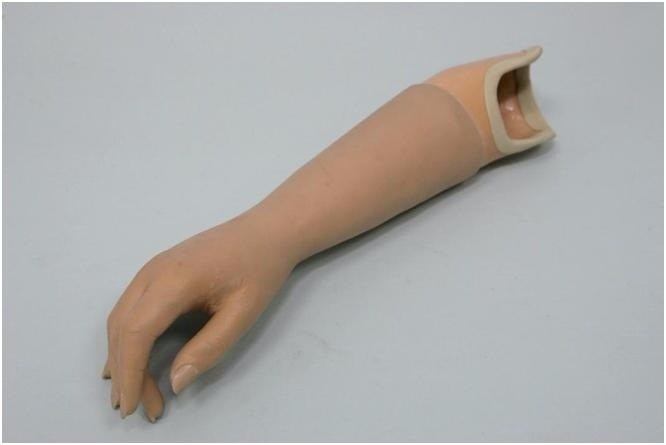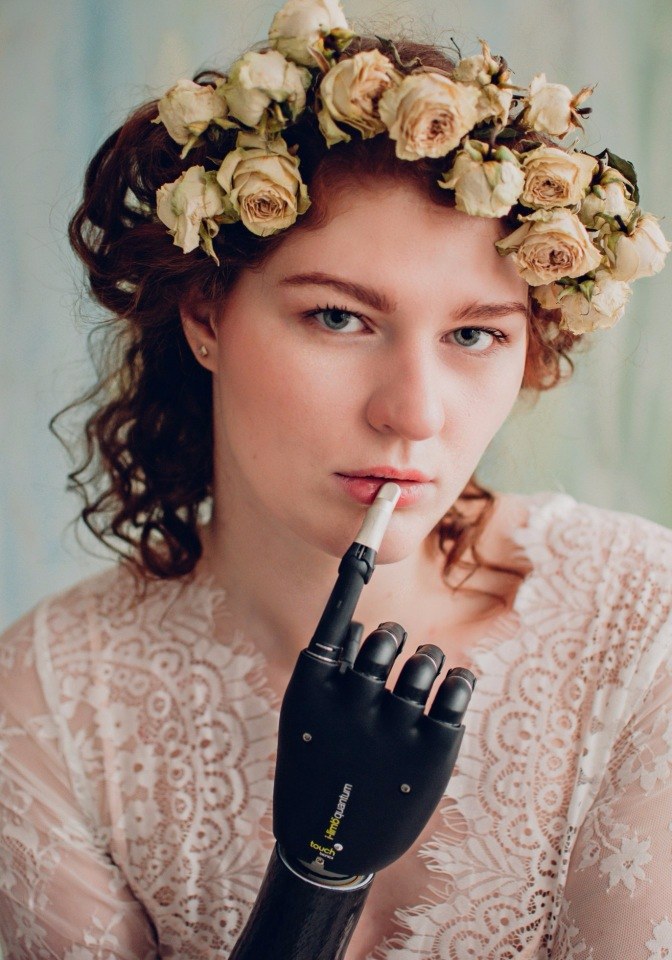How to become a cyborg in Russia (and how much it costs)

It is no secret that bionic prosthetics is sooo expensive. Both in Russia and abroad, it is possible to get a high-tech prosthesis to a minimum number of potential users.
So how do you get a cool prosthesis to an ordinary person? While our team is developing an affordable bionic prosthetic arm , I will tell you how Russian disabled people can become cyborgs today.
How much does it cost to become a cyborg
At the end of last year, the prosthesis of the forearm with the bioelectric brush Bebionic 3 cost about 1.8 - 2 million rubles in Russia. The shoulder prosthesis will be more expensive - the elbow joint adds about 200-300 thousand rubles to the total amount. It is necessary to understand that the cost of a prosthesis depends on the level of amputation, the region where the prosthesis is installed and the accessories (an electric wrist rotator, for example, costs several hundred thousand rubles).
')
More advanced brushes (for example, Michelangelo hand and I-limb Quantum) cost one and a half to two times more expensive.

Michelangelo hand and I-limb Quantum
There are options and simpler. In 2014, the Otto Bock Myofacil brush cost about 750 thousand rubles. Given that Otto Bock annually raises prices, I assume that now such a prosthetic forearm costs about 1 million rubles.

Myofacil
The cost of a prosthesis usually includes the work of a prosthetist (that is, the manufacture of a culture-receiving sleeve), a charger, a spare battery, a cosmetic glove (at the rate of one glove for six months), as well as warranty repairs for a period of 2 years. Otto Bock prosthesis also supplies prosthesis care products, and Bebionic 3 comes with a Bluetooth adapter and a CD with software for adjusting the brush.
Currently, there are three ways to purchase a high-tech prosthesis:
1. Get at the expense of the state.
2. Buy at your own expense.
3. Through charitable foundations and crowdfunding.
I will not consider the last two options now. Because even if you have a couple of free millions of rubles, or if some foundation or benefactor buys you a prosthesis, this will not solve the problem in the long run. After 2 years, the prosthesis will expire warranty, and with active use, the prosthesis will necessarily break.
By the way, this is why we, in Motorika, started repairing prosthetic hands and are ready to maximize the life of artificial limbs. But after a few years, the prosthesis will still have to be changed. Therefore, if you do not have a multimillion-dollar salary, you should seriously consider only prosthetics at the expense of the Social Insurance Fund.
An important point. Unfortunately, I personally came across people who received bionic prostheses and did not use them. Bebionic3, received from the state for 2 million rubles, may lie on a dusty shelf. Why? Because many people with disabilities get used to doing without a prosthesis, and it hinders them more than helps. Or, for example, a person received a prosthetic brush, but he was too lazy to learn or control of the prosthesis seemed too complicated. Please do not do this. The budget of the Social Security Fund is not infinite, but the prosthesis that you received for free and did not use as a result could really improve someone’s life.
Cyborgization at state expense
According to the legislation, all citizens of the Russian Federation with disabilities have the right to receive technical means of rehabilitation (TSR) at the expense of the state . It is for such things that we all pay taxes and fees, we are collectively responsible and can receive collective support if necessary. Prosthesis for budget money can be obtained in two ways:
1. Purchase the TSR independently and then receive compensation for the prosthesis from the state.
The main problem with this option is that in some regions people with disabilities are not compensated for the full amount spent on the prosthesis. The amount of compensation depends on the amount of the last realized tender. And in such competitions prosthesis wins, which costs the least. Often, some kind of prosthesis developed in the 70s that the user does not even wear is a winner. Because of this, for example, in the Voronezh region compensation for the acquired bionic prosthesis of the hand is about 150 thousand rubles.
2. Get prosthesis through government procurement
The procedure for obtaining a good prosthesis for a state account is, as a rule, a long and complicated procedure and not all people with disabilities receive the exact TCP that they want. The success of this event is highly dependent on the well-being of the region - in Moscow and St. Petersburg getting bionics is much easier than in the provinces.
The main stages (for example, getting bionic hands):
1. First, a person who has lost a hand must undergo a medical and social assessment (ITU) .
ITU is a kind of medical consultation that sets a group of disabilities and determines which rehabilitation measures a disabled person needs to recover lost functions (both from a medical and a social point of view).
It is the ITU that determines whether a bionic prosthesis is laid on a person, or will it cost hooks or a cosmetic prosthesis at all:

traction shoulder prosthesis

cosmetic prosthesis forearm
What is the ITU guided by the appointment of a prosthesis? The diagnosis and "perspectivity" of the disabled person. That is, if you are young and ambitious, and the bionic prosthesis will allow you to lead an active social life (for example, get a job), your chances of getting bionics will be higher than those of the old recluse. In addition, there is a list of contraindications for prosthetics, such as mental disorders in the acute stage, etc. A direct contraindication for obtaining bionics is the weak activity of the muscles responsible for controlling the prosthesis.
Suppose everything went well, a disabled person went to a meeting at the MSE and he received an individual rehabilitation program marked “A prosthetic arm with an external source of energy.” Now the state is obliged to provide it with a bioelectric prosthesis.
2. A disabled person writes an application to the local Social Insurance Fund, where he is given a referral for prosthetics within two weeks (by law). In theory, the FSS places an application for prosthetics at an auction in which various prosthetic enterprises are involved and the disabled person will be prosthetic in the company that offers the minimum price for making the desired prosthesis.
3. PROFIT. A satisfied disabled person gets a steep prosthesis and lives happily. After 3 years, the bionic prosthesis can be changed, again at the expense of the FSS.
But back to reality. Getting a prosthesis can take years or not be successful. At each of these stages, you can permanently get stuck.
The fact is that in Russia there is a system in which the effectiveness of the Social Insurance Fund is estimated by the number of issued TSRs. And what is more profitable: to give a bionic brush to one disabled person for a million, or to give prosthetic hooks to 30 disabled people for the same money? That's it. Therefore, the state seeks to provide as much cheap TSR as possible to the largest possible number of people with disabilities. And this is to some extent justified, because according to statistics, only one third of those in need are provided with prosthetic hands in Russia.
That is why one of the main areas of work of “Motoriki” is cooperation with government agencies and prosthetic enterprises. We are actively traveling around the country and in many regions we find the support of caring officials and prosthetists who really want to change the outdated system. We managed to certify in a short time and start mass production of Kibi traction prostheses . In some regions, for example, in Arkhangelsk, Novosibirsk and Novokuznetsk, our prostheses can already be obtained directly at local prosthetic enterprises.
Of course, it is impossible to change the system and the people in it overnight. In a provincial city, a conditional Antonina Ivanovna from the ITU never saw the artificial limbs she appointed herself. She used to always prescribe cosmetic dentures, not realizing that such a prosthesis is practically useless in everyday life. Or her colleague, conditional Valentin Petrovich, who doesn’t really understand anything in prostheses and asks the disabled person what kind of prosthesis to fit in him, and grumbles at the noisy mother with the child and in general he has lunch.
The story of Svetlana Churakova from Arkhangelsk is well suited to illustrate the hell, through which sometimes Russian disabled people have to pass. She took one of the top bionic hands in her two years. One year went to trial with the ITU - she had long been refused to appoint bionics. It even went so far that she was summoned for a federal examination to Moscow, where she was forced to wash her dishes revealingly to find out how well she was coping with the old traction prosthesis. Like, maybe she doesn’t need a new one at all? It took about a year to correspond with the FSS and actively defend their rights. But, largely due to the active support of the Arkhangelsk prosthetic enterprise, she succeeded and now Sveta has turned into a real bionic princess:

I repeat that in some regions of our country the system is more supportive of people with disabilities and it is quite realistic to get a quality prosthesis there. Taking this opportunity, I want to thank all the workers in the industry who welcome the changes (there are many such people) and help people with disabilities get really useful, modern means of rehabilitation.
Ok. Is it better abroad?
No, not better. Getting a bionic prosthesis for free is not easy at all in Europe and the USA.
According to Jason Barnes, American cyborg drummer and Bebionic3 user, getting a bionic prosthesis in the US is “unrealistically hard,” and the final cost of a prosthesis with insurance can reach $ 100,000.

Jason barnes
And here is what the Englishman Nigel Ekland told me, whom you can know from the official Bebionic commercials:
The cost of Bebionic 3 in England is around £ 15,000. Another £ 6,000 - £ 10,000 is worth making a culture receiving sleeve.
Getting Bebionic in England is a difficult task. The National Health Service provides bionics for 10-15 people per year. Almost everyone I know is trying to raise money for a prosthesis on their own, and they also have to collect money for warranty service or insurance against breakdowns.
I have high hopes for 3D printing - this is the only way to “rein in” greedy corporations. Printing dentures on 3D printers will allow many people to have good dentures. I think this is wrong when large companies benefit from people's failures.

Nigel Ackland
On this optimistic note, I once again remind you that the future is coming and our team is already doing everything today to make affordable high-tech prostheses in Russia. The Stradivari bioelectric brush is on the way. Follow the news!
If you are legally equipped with a prosthesis, but you cannot get it due to bureaucratic delays, drop us a line and we will do our best to help you.
PS Friends, maybe there is something that especially interests you in the subject of bionics and high-tech prosthetics in Russia? Write your questions and suggestions in the comments.
Source: https://habr.com/ru/post/373249/
All Articles